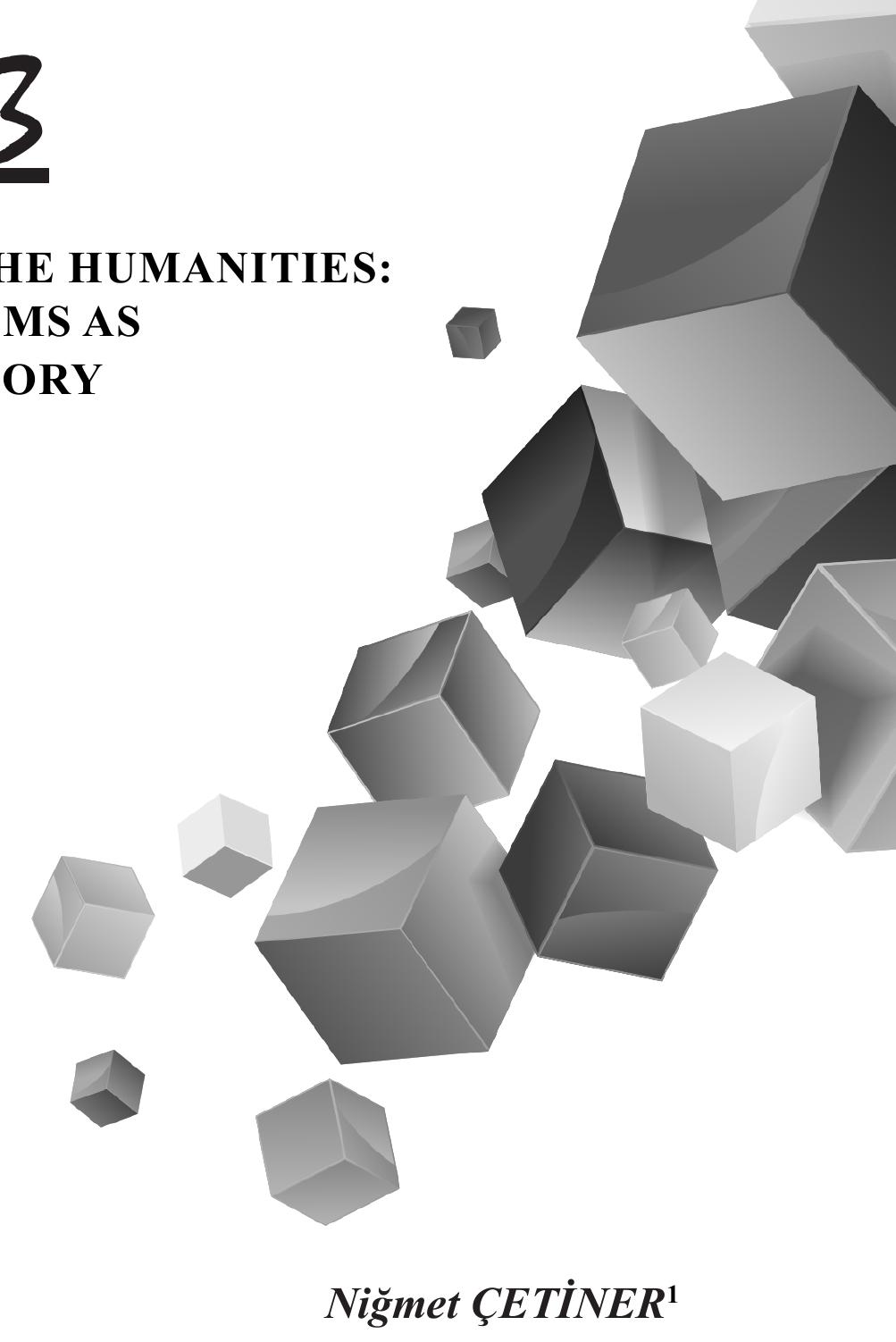A RECENT TREND IN THE HUMANITIES: THE NEW MATERIALISMS AS PHILOSOPHY AND THEORY (original) (raw)
2020, Theory and Research in Social, Human and Administrative Sciences II (Cilt 2)
Abstract
The New Materialisms is a theory that has its origins in theoretical physics. Its aim is to create awareness about the entanglements of humans and the more-than-human worlds so that humans will act more cautiously towards the environment and will likely include ontology and ethics in their process of scientific knowledge production. This recent theoretical and sociological field of inquiry, “The New Materialisms”, has been intensely explored since 1990 and prominent scholars from various disciplines such as Karen Barad, Susan Hekman, Jane Bennett, Stacy Alaimo, Bruno Latour, Gilles Deleuze, David Abram, Donna Haraway, Rosi Braidotti, Vicky Kirby, Diana Coole and Samantha Frost support the idea that anthropocentric exceptionalism must be abandoned since no entity, animate or inanimate, can be deemed superior to another. Agency, which has long been thought to belong only to humans, is evenly distributed to all that is made of matter, so they are ontologically independent and do not need human consciousness or interpretation to exist. The New Materialisms is against any kind of speciesism. Concordantly, the idea is to emphasize the necessity to understand the connection, the interaction, or intra-action in Barad’s words, and interdependence arising from the symbiosis in order to facilitate the continuity of the ecosystems whose destruction means the destruction of the human species along with the nonhuman environment. Within the framework of this theory, there is a “material turn” (2010: 7), as Alaimo puts it in her work; namely, there is an inclination to equalize the importance of the ontology of humans with that of nonhuman bodies (2010: 2). According to New Materialists, neither is superior in terms of agency. Therefore, the theory provides a fresh and dynamic way of interpretation to academic disciplines such as philosophy, social sciences, history, anthropology, literature and theology holding the potential to change the traditional mind-set. It facilitates the rethinking the relationship between nature and culture as nature-cultures. Moreover, New Materialisms is especially popular in literature as a medium of interpreting literary texts in terms of human and nonhuman intra-action.
Figures (1)

Loading Preview
Sorry, preview is currently unavailable. You can download the paper by clicking the button above.
References (30)
- ALAIMO, Stacy. (2010). Bodily Natures: Science, Environment and the Material Self. Bloomington: Indiana University Press.
- BARAD, Karen. (2007). Meeting the Universe Halfway: Quantum Physics and the Entanglement of Matter and Meaning. Durham: Duke University Press.
- ------------. (2003). "Posthumanist Performativity: Toward an Understanding of How Matter Comes to Matter" Journal of Women in Culture and Society, 28 (3): 801-831.
- BAYSAL, Kübra. (2016). "Way(s) of Nature and Trans-Corporeality in The Rime of the Ancient Mariner" The Criterion: An International Journal in English, 7 (6): 184-190.
- BENNETT, Jane. (2010). Vibrant Matter. Durham: Duke University Press.
- COLE, Nicki Lisa. (2017). "Agency, a Sociological Definition" ThoughtCo. Date of Access: 13 September 2017, https://www.thoughtco.com/agency- definition-3026036
- COOLE, Diane and FROST, Samantha. (2010). "Introducing New Materialisms" The New Materialisms: Ontology, Agency, and Politics, 1-43.
- DELANDA, Manuel. (2016). Assemblage Theory. Edinburgh: Edinburg University Press.
- DELANDA, Manuel and PARNET, Claire. (2007). Dialogues II. New York: Columbia University Press.
- DELEUZE, Giles and GUATTARI, Felix. (1987). A Thousand Plateaus. USA: University of Minnesota Press.
- DOLPHIJN, Rick and TUIN, Iris van der. (2012). The New Materialisms: Interviews and Cartographies. Ann Arbor: Open Humanities Press.
- DWIARTAMA, Angga and ROSIN, Christopher. (2014). "Exploring Agency Beyond Humans: The Compatibility of Actor-Network Theory (ANT) and Resilience Thinking" Ecology and Society, 19 (3): 28.
- ELLENZWEIG, Sarah and ZAMMITO, John. (Eds.). (2017). The New Politics of Materialism: History Philosophy, Science. New York: Routledge.
- FAUSTO-STERLING, Anne. (2005). "The Bare Bones of Sex: Part 1-Sex and Gender" Signs: Journal of Women in Culture and Society, 30 (2): 1491- 1527.
- FROST, Samantha. (2011). "The Implications of the New Materialisms for the Feminist Epistemology" Feminist Epistemology and Philosophy of Science: Power in Knowledge, 69-84.
- GEERTS, Evelien. (2016). Ethico-onto-epistemology. Date of Access: 15 September 2017, http:// newmaterialism.eu/almanac/e/ethico-onto- epistem-ology HARAWAY, Donna. (2003). The Companion Species Manifesto: Dogs, People and Significant Otherness. Chicago: University of Chicago Press.
- HEKMAN, Susan and ALAIMO, Stacy. (2007). Material Feminisms. Bloomington: Indiana University Press.
- History of Consciousness. (n.d.). Date of Access: 11 November 2020, https:// histcon.ucsc.edu/faculty/index.php?uid=kbarad
- IOVINO, Serenella. (2012). "Steps to a Material Ecocriticism. The Recent Literature About the 'The New Materialisms' and Its Implications for Ecocritical Theory" Ecozon@, European Journal of Literature, Culture and Environment, 3 (1): 134-145.
- IOVINO, Serenella and OPPERMANN, Serpil. (2014). Material Ecocriticism. USA: Indiana University Press.
- IOVINO, Serenella and OPPERMANN, Serpil. (2012). "Material Ecocriticism: Materiality, Agency, and Models of Narrativity" Ecozon@, European Journal of Literature, Culture and Environment, 3 (1): 75-91.
- LATHER, Patti. (2016). "Top Ten+ List: (Re)Thinking Ontology in (Post) Qualitative Research". Cultural Studies ↔ Critical Methodologies, 16(2): 125-131
- NAIL, Thomas. (2017). "What is an Assemblage?" Substance, 46 (1): 21-37.
- OPPERMANN, Serpil. (2013). "Material Ecocriticism and the Creativity of Storied Matter" Frame, 26 (2): 55-69.
- POTTER, Emily and HAWKINS, Gay. (2009). Naturecultures: Introduction. Date of Access: 6 August 2017, http://australianhumanitiesreview. org/2009/05/01/naturecultures-introduction/
- RITZER, George. (Ed.). (2005). Encyclopedia of Social Theory. Maryland: Sage Publications.
- SJOBERG, Laura. (2016). "Mattering, Feminism, Science, and The New Materialisms" International Feminist Journal of Politics, 21 (2): 345-370.
- TILLMAN, Rachel. (2015). "Toward a The New Materialisms: Matter as Dynamic" Minding Nature, 8 (1): 30-35.
- TUANA, Nancy. (2008). "Viscous Porosity: Witnessing Katrina" Material Feminisms, 188-213.
- TUIN, Iris van der. (2009). "'Jumping Generations': On Second-and Third- Wave Feminist Epistemology" Australian Feminist Studies, Special issue: Generation: On Feminist Time-Lines. 24 (59): 17-31.
